This article relies largely or entirely on a single source .(April 2012) |


The Salty Dawg Saloon is a well-known landmark on the Homer Spit in Homer, Alaska.
This article relies largely or entirely on a single source .(April 2012) |


The Salty Dawg Saloon is a well-known landmark on the Homer Spit in Homer, Alaska.
The Salty Dawg originally was one of the first cabins built in Homer in 1897, soon after the establishment of the town site.[ citation needed ]
It was acquired in the late 1940s by Chuck Abbott.[ citation needed ] In 1949 Chuck and his friend Gerald Gifford put the cabin on skids and moved it to the Homer Spit.[ citation needed ] In April 1957, he officially opened it as the Salty Dawg Saloon.[ citation needed ] By 1960 the Salty Dawg Saloon had a building adjacent to it, coinciding with The Alaska Territory becoming the 49th state of the union in January 1959.[ citation needed ]
Earl D. Hillstrand (1913-1974), an attorney, small businessman and member of the Alaska House of Representatives, purchased it in 1960.[ citation needed ] Although an Anchorage resident, Hillstrand had a homestead near Homer and was in the process of developing the nearby Land's End Resort at the time.[ citation needed ]
The Salty Dawg Saloon is currently owned and operated by John Warren.[ citation needed ]
The saloon has been featured on Deadliest Catch on the Discovery Channel.[ citation needed ] The bar is known for the thousands of dollar bills signed by visitors and tacked to the walls. This practice started many years ago, when a visitor tacked a dollar on the wall, explaining that his friend would be by later. The dollar was intended for buying the friend a drink. [1]
Fritz Creek is a census-designated place (CDP) in the Kenai Peninsula Borough, Alaska, United States, northeast of Homer. At the 2020 census the population was 2,248, up from 1,932 in 2010.

Halibut Cove is a census-designated place (CDP) in Kenai Peninsula Borough, Alaska, United States. The population was 76 at the 2010 census, up from 35 in 2000.
Homer is a city in Kenai Peninsula Borough in the U.S. state of Alaska. It is 218 mi (351 km) southwest of Anchorage. According to the 2020 Census, the population is 5,522, up from 5,003 in 2010. Long known as the "Halibut Fishing Capital of the World", Homer is also nicknamed "the end of the road", and more recently, "the cosmic hamlet by the sea".
Nanwalek, formerly Alexandrovsk and later English Bay, is a census-designated place (CDP) in the Kenai Peninsula Borough, Alaska, United States, that contains a traditional Alutiiq village. The population was 254 at the 2010 census, up from 177 in 2000. There is one school located in the community, attended by 76 students.

The Municipality and Borough of Skagway is a first-class borough in Alaska on the Alaska Panhandle. As of the 2020 census, the population was 1,240, up from 968 in 2010. The population doubles in the summer tourist season in order to deal with more than 1,000,000 visitors each year. Incorporated as a borough on June 25, 2007, it was previously a city in the Skagway-Yakutat-Angoon Census Area. The most populated community is the census-designated place of Skagway.

Bettles is a city in Yukon-Koyukuk Census Area, Alaska, United States. It is near Gates of the Arctic National Park and Preserve. The population was 23 at the 2020 census, up from 12 in 2010. It is the second smallest incorporated city in the state.
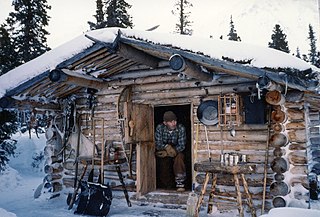
Richard Louis Proenneke was an American self-educated naturalist, conservationist, writer, and wildlife photographer who, from the age of about 51, lived alone for nearly thirty years (1968–1998) in the mountains of Alaska in a log cabin that he constructed by hand near the shore of Twin Lakes. Proenneke hunted, fished, raised and gathered much of his own food, and also had supplies flown in occasionally. He documented his activities in journals and on film, and also recorded valuable meteorological and natural data. The journals and film were later used by others to write books and produce documentaries about his time in the wilderness.

Silver Dollar City is a 61-acre (25 ha) amusement park in Stone County, Missouri, near the cities of Branson and Branson West. The park is located off of Missouri Route 76 on the Indian Point peninsula of Table Rock Lake. Silver Dollar City opened on May 1, 1960. The park is an 1880s-themed experience. Silver Dollar City's operating season runs from March until December, with the park closed for two months. Silver Dollar City is owned by Herschend Family Entertainment.

Jefferson Randolph "Soapy" Smith II was an American con artist and gangster in the American frontier.

A Western saloon is a kind of bar particular to the Old West. Saloons served customers such as fur trappers, cowboys, soldiers, lumberjacks, businessmen, lawmen, outlaws, miners, and gamblers. A saloon might also be known as a "watering trough, bughouse, shebang, cantina, grogshop, and gin mill". The first saloon was established at Brown's Hole, Wyoming, in 1822, to serve fur trappers.

Kachemak Bay Campus (KBC) is a campus of Kenai Peninsula College, which is a unit of the University of Alaska Anchorage. Located in Homer, KBC has a student population of about 500. The college was formerly divided into two campuses, referred to as east and west campuses respectively. The college had proposed purchasing Homer's city hall, which is adjacent to the east campus, in order to consolidate their facilities, but this would have been part of a larger project to build a new city hall and a town square in Homer, and the plan was rejected by voters. The college eventually decided to build an entirely new facility on the existing campus property. The new facility, known as Bayview Hall opened after spring break in 2011. The hall is 7,000 square feet (650 m2) and cost 2.5 million dollars to construct. It contains new classrooms, faculty offices, and a multi purpose "learning center."

The Red Dog Saloon is a drinking establishment at 278 South Franklin Street in Juneau, Alaska, U.S. The Red Dog has been recognized by the Alaska Legislature for its longevity as the oldest man-made tourist attraction in Juneau.

Ghost Town Village is an abandoned Wild West-themed amusement park in Maggie Valley, North Carolina, United States whose status is currently, as of March 2023, the subject of an ongoing lawsuit. It sits atop Buck Mountain, with a top elevation of 4,650 ft (1,420 m). Ghost Town is promoted as "North Carolina's mile-high theme park."

The Homer Spit is a geographical landmark located in Homer, Alaska on the southern tip of the Kenai Peninsula. The spit is a 4.5-mile (7.2 km) long piece of land jutting out into Kachemak Bay. The spit is also home to the Homer Boat Harbor. The harbor contains both deep and shallow water docks and serves up to 1500 commercial and pleasure boats at its summer peak. Additional features and attractions include The Nick Dudiak Fishing Lagoon, which is an artificial "fishing hole", campgrounds, hotels, and restaurants and the Salty Dawg Saloon, which is constructed out of several historic buildings from Homer. Hundreds of eagles formerly gathered there in winter to be fed by Jean Keene, the "Eagle Lady".

Captain Tony's Saloon is a bar in Key West, Florida, United States, located at 428 Greene Street.
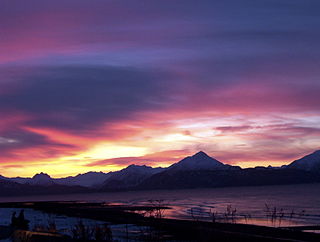
Kachemak Bay State Park and Kachemak Bay State Wilderness Park is a 400,000-acre (1,600 km2) park in and around Kachemak Bay, Alaska, United States. Kachemak Bay State Park was the first legislatively designated state park in the Alaska State Parks system. Kachemak Bay State Wilderness Park is the state's only legislatively designated wilderness park. No road accesses most areas of the park; visitors normally fly in or travel by boat from Homer.
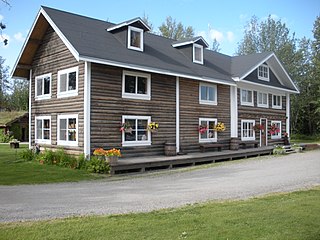
Rika's Landing Roadhouse, also known as Rika's Landing Site or the McCarty Roadhouse, is a roadhouse located at a historically important crossing of the Tanana River, in the Southeast Fairbanks Area, Alaska, United States. It is off mile 274.5 of the Richardson Highway in Big Delta.
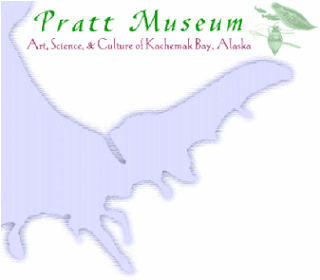
The Pratt Museum is a regional natural history museum located in Homer, Alaska, with exhibits exploring life around Kachemak Bay in South Central Alaska. The museum's mission is to preserve "the stories of the Kachemak Bay region", through "collections, exhibits, and programs in culture, science, and art". Indoor exhibits include early homesteading, Native Alaskan traditions, local contemporary art, and an exploration of the marine and terrestrial life around Kachemak Bay. Outdoor exhibits feature a historic cabin, botanical gardens and a nature trail.

The Nome Gold Rush was a gold rush in Nome, Alaska, approximately 1899–1909. It is separated from other gold rushes by the ease with which gold could be obtained. Much of the gold was lying in the beach sand of the landing place and could be recovered without any need for a claim. Nome was a sea port without a harbor, and the biggest town in Alaska.
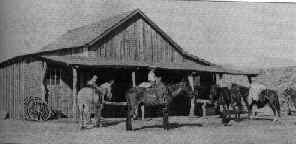
Klondyke is a populated place in Graham County, Arizona, United States that was founded circa 1900 by some miners who had recently returned from Alaska after participating in the Klondike Gold Rush. The town is located west of Safford in the Aravaipa Valley. The Galiuro Mountains lie to the southeast and the Santa Teresa Mountains to the north.